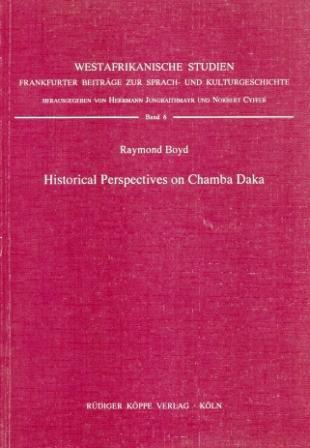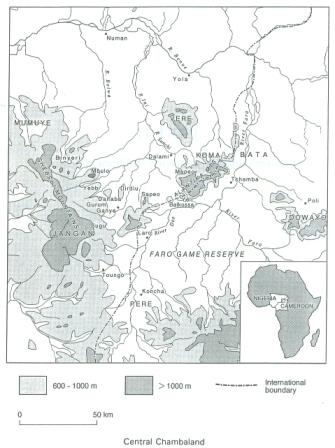

Historical Perspectives on Chamba Daka
– including an English-Chamba Lexicon
Author: Raymond Boyd. Series edited by: Herrmann Jungraithmayr, Norbert Cyffer.
Series: WeStu Westafrikanische Studien Volume 6
1994206 pp.
1 map: Central Chambaland, Gbaya Genealogical Tree, 35 tables, List of borrowings between Chamba Daka, Chamba Leko and other regional languages, English-Chamba Daka lexicon
Text language(s): English
Format: 170 x 240 mm
350 g
Paperback
€ 49.80
Buy 'Historical Perspectives on Chamba Daka' as a downloadable PDF document directly from our online shop »
Order 'Historical Perspectives on Chamba Daka' as print edition »
The Chamba are an ethnic group composed of speakers of two quite different languages belonging to the Niger-Congo family. In ethnographic literature, these languages are traditionally called Daka and Leko. Since the speakers of many dialects of both of these languages identify themselves as members of the Chamba ethnic group, they are referred to here as Chamba Daka and Chamba Leko respectively. The name Chamba Daka does not designate a homogenous linguistic unit, but rather a set of dialects whose exact degree of diversity has not yet been precisely determined in every case.
Chambaland, i.e. the central Chamba area, where the majority of the Chamba live, straddles the present border between Nigeria and Cameroon. Chamba Leko speakers are restricted to the easternmost part of the central area, for the most part on the Cameroon part of the modern border. The remainder of the Chamba are Daka-speaking. Greenberg’s classification of Chamba Daka as a member of the Adamawa group of the Niger-Congo family is not uncontested nowadays. Likewise, attempts to group it under the northern branch of the Bantoid languages have proven difficult.
Given the linguistic situation as a whole on the Central African savanna south of Lake Chad, where dozens of quite distantly related languages are packed together, the number and complexity of the changes which have taken place are surely such as to make them unrecoverable by any comparative technique. This is why we must severely limit our expectations in the historical linguistics of these languages and accept that we are much more likely to be able to prove influence than genetic connection.
We are nevertheless faced with the question of where the vocabulary of Chamba Daka does come from. In order to illuminate the similarities between the vocabularies of Chamba Daka and Chamba Leko, this work discusses a list of lexical equivalents which are considered to be loans.
Under these links you will find further descriptions of Adamawa languages:
Accompanying material:
- A Grammar of Mambay
(ISBN 978-3-89645-425-6 ) - A Study of Mambila – Emmi Meyer’s Mambila-Studie
(ISBN 978-3-89645-234-4 ) - Afrikanische Sprachen im Fokus
(ISBN 978-3-89645-196-5 ) - Contes des Bakas (Sud-Est Cameroun)
(ISBN 978-3-89645-272-6 ) - Dictionnaire dii (dourou) — français
avec indexes français et anglais
(ISBN 978-3-89645-432-4 ) - Dictionnaire mambay-français. Index français-mambay
(ISBN 978-3-89645-430-0 ) - Die Sprache der Fali in Nordkamerun
(ISBN 978-3-89645-561-1 ) - Linguistische Beschreibung des Kolbila
(ISBN 978-3-89645-569-7 )
Cross-reference:
- Current Approaches to Adamawa and Gur Languages
(ISBN 978-3-89645-233-7 ) - Mechthildian Approaches to Afrikanistik – Advances in Language Based Research on Africa
(ISBN 978-3-89645-226-9 ) - Proceedings of the 4th WOCAL World Congress of African Linguistics, New Brunswick 2003
(ISBN 978-3-89645-338-9 ) - Proceedings of the 6th WOCAL World Congress of African Linguistics, Cologne, 17-21 August 2009
(ISBN 978-3-89645-199-6 ) - Transitivity in African Languages
(ISBN 978-3-89645-726-4 ) - Vorkoloniale Geschichte und Expansion der Avungara-Azande
(ISBN 978-3-89645-209-2 )
Reviews
Ulrich Kleinewillinghöfer in Afrika und Übersee, 78/1995, 305-308
| « back | Print version | [top] |
 Books
Books Audio
Audio Biographies
Biographies Series
Series Festschrifts
Festschrifts Journals
Journals